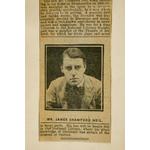Casualties
James Crawford Neil
Francis Sheehy-Skeffington was well known in Dublin and would be regarded as a public figure. More representative perhaps of the generality of the civilian fatalities was James Crawford Neil, a young man relatively unknown outside his family, his place of work and his circle of friends and acquaintances. James Crawford Neil (1887-1916) was a Presbyterian by religion and a typical enough young Dubliner living in Drumcondra. He worked as a library assistant in the National Library of Ireland.
On Tuesday 25 April the National Library was closed due to the Rising. Neil availed of the day off to travel to Glasthule, a village out beyond Kingstown (Dun Laoghaire), to visit his fiancée. The fiancée was an actress named Patricia (‘Gypsy’) Walker, a sister of Máire Ní Shiubhlaigh, also an actress and one of the Cumann na mBan women then ensconced in Jacob’s biscuit factory. On his way home that evening he avoided Sackville Street because it was dangerous, and crossed the Liffey further to the west, where his fate awaited him. It appears that he was remonstrating with a looter when he was shot in the back, possibly by a stray bullet, or by a bullet fired by a soldier or Volunteer who mistook him for a looter. He died in Jervis Street Hospital on 10 May.
Among other things, James Crawford Neil was a promising poet just about to have his first collection published. Published it was, but by then he was dead: Happy Island: Child Poems by Crawford Neil was edited by F.R. Higgins and published in Dublin in July 1916.
James Crawford Neil might well have written more poems. He might also very well have had a family: his grand- children or great-grandchildren might well be now walking among us in Dublin—one might even be a poet. It was the fate of James Crawford Neil that his intriguing potential was never to be realised, no more than that of any of the other civilian casualties, nor indeed any more than that of any of the combatant casualties—but they at least had a say in the choosing of their destiny.



